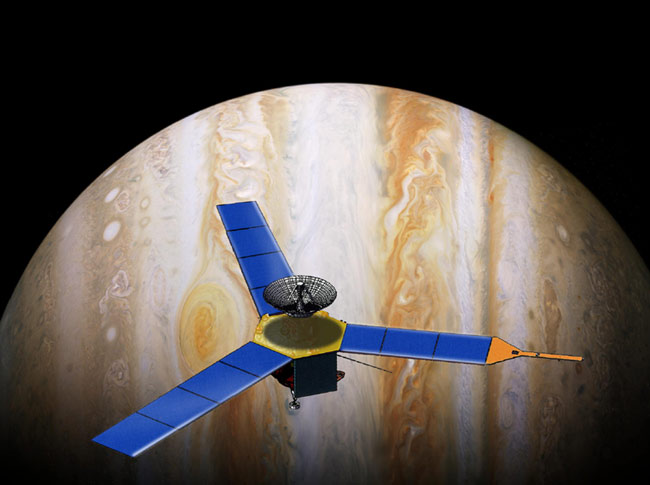NASA Chooses Rocket for Next Jupiter Probe

NASA haschosen the rocket to launch its next robotic probe to Jupiter. An Atlas 5 model551 rocket, provided by Lockheed Martin Commercial Launch Services, will sendoff NASA?s $700 million Juno mission in August 2011, the space agency said.
?Gettingthe launch vehicle contract this early in the process is very helpful for us,?said Scott Bolton, principal investigator for Juno?s missionat the Southwest Research Institute in San Antonio, Texas. The early decision allows Bolton and other researchers more time to prepareJuno's science instruments for launch conditions.
Thesolar-powered Junospacecraft is scheduled to arrive at Jupiter in 2016, where it will spend ayear in polar orbit peering beneath the gas giant?s clouds. Unlike spacecraftthat have swiveling cameras to look around, Juno will spin in orbit so itsoutward-looking cameras get continual glimpses of the planet. That will allowits instruments to study Jupiter?s interior, atmosphere, and polarmagnetosphere.
Juno willtake gravitational measurements to detect the influence of any ice-rock corehiding beneath the hydrogen and helium haze, revealing the planet?s internalstructure. The probe will also use a microwave spectrometer to study how muchwater and ammonia compose the planet?satmosphere.
Because Jupiter contains most of the water in the solarsystem, studying its current water abundance may help scientists understand howmuch ice was present when the planets were just forming.
Severalinstruments onboard Juno will also observe Jupiter?s magnetic field andmagnetosphere. The Jovian Auroral Distributions Experiment (JADE) will studythe charged particles that interact with the planet'smagnetic field to make up Jupiter?s aurora – a phenomenon similar to theAurora Borealis or ?northern lights? of Earth.
Meanwhile, the Juno Ultraviolet Spectrograph (UVS) willstudy the ultraviolet emissions of the aurora by taking images directly abovethe north and south poles of Jupiter. Scientists can then combine thesimultaneous observations with direct images of the aurora to get an overallpicture of the planet.
Breaking space news, the latest updates on rocket launches, skywatching events and more!
An earlierdelay in the Juno mission proposal allowed Bolton and his colleagues to add an infrared instrument supplied by theItalian Space Agency. The infrared spectrometer will provide additional viewsof both Jupiter?s atmosphere and aurora.
Previousmissions that involved flybys or long term orbits of Jupiter – includingPioneer, Voyager, and Galileo – laid the groundwork for scientists to further focustheir attention on the solar system?s largest planet. The Cassini and NewHorizons probes also performedflybys.
?What welearned was that Jupiter is very important if we?re going to understand originof planets and how they?re made,? Bolton said. By selectively studying certain planetary features, Juno will helpfurther that understanding, he added.
Juno willbe the second mission in NASA?s New Frontiers program. The planned spaceflightwill undergo design reviews in May, after which it will receive flightconfirmation and enter the critical design phase.
NASA alsochose an Atlas 5 rocket to launch a separate science mission, theEarth-watching Landsat Data Continuity Mission, slated for a July 2011 liftoff.
- VIDEO: New Horizon's Jupiter Flyby
- IMAGES: New Views of Jupiter
- All About Jupiter
Join our Space Forums to keep talking space on the latest missions, night sky and more! And if you have a news tip, correction or comment, let us know at: community@space.com.
Jeremy Hsu is science writer based in New York City whose work has appeared in Scientific American, Discovery Magazine, Backchannel, Wired.com and IEEE Spectrum, among others. He joined the Space.com and Live Science teams in 2010 as a Senior Writer and is currently the Editor-in-Chief of Indicate Media. Jeremy studied history and sociology of science at the University of Pennsylvania, and earned a master's degree in journalism from the NYU Science, Health and Environmental Reporting Program. You can find Jeremy's latest project on Twitter.
